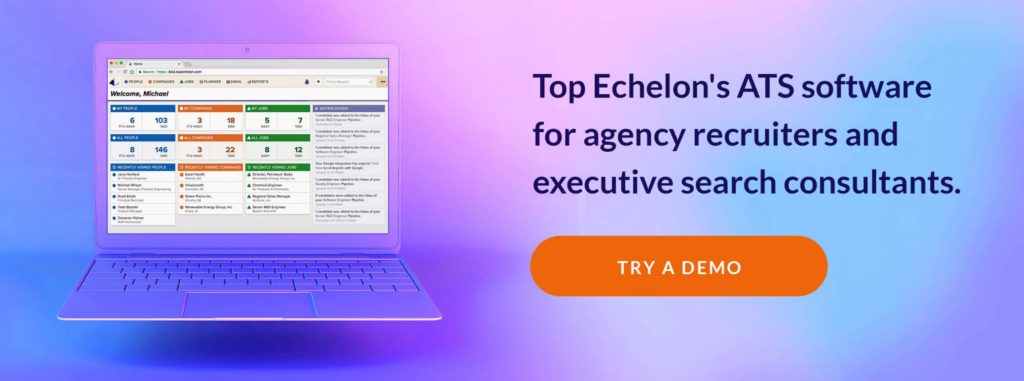The reluctance of hiring authorities to pull the trigger on a quality candidate can be a mind-numbing, hair-pulling, stress-laced experience for any recruiter. You’ve probably already discovered that there’s almost nothing you can say during the recruitment process steps that will speed them up. However, the questions you ask and what you do before the recruiting process begins holds the key to avoiding another angst-riddled adventure.
if there’s one thing that a professional recruiter or search consultant can NOT afford to waste is time. That’s because time is money, and the more you waste of one, the more you waste of the other. So how can we make sure that you don’t do either?
The recruiting process: on the fast track
By taking time up front to set clear and concrete expectations through communication, you can either:
- Ensure a timely interview and selection process.
- Identity the search as one that is going to involve a slow process and either prepare for it or turn it down.
What follows are suggestions for setting those expectations so you don’t lose any more hair than you already have.
Below are five ways that recruiters can speed up the recruiting process:
#1—Determine if filling the position is a priority.
One key strategy to expedite the recruiting process is to delve into the sense of urgency with the hiring authority. While the term “ASAP” might be commonly thrown around, it often lacks clarity and can lead to delays. Instead of accepting a vague timeframe, recruiters should proactively engage with the hiring authority to pinpoint a more concrete schedule. This involves steering away from the generic question of when they want the position filled and, instead, focusing on scheduling face-to-face interviews.
By asking the hiring authority about their preferred timeline for conducting face-to-face interviews, recruiters set clear expectations from the outset. This approach not only prompts a more specific response but also provides insights into the actual urgency behind the position. If the hiring authority is hesitant or reluctant to establish a preliminary interview schedule, it signals that the position may not be an immediate priority.
Understanding the level of urgency enables recruiters to allocate resources efficiently. Positions with a high degree of urgency may warrant a more aggressive and accelerated recruiting strategy, including expedited screening processes and prioritized candidate engagement. Conversely, for roles with lower urgency, recruiters can adopt a more measured approach, balancing thorough candidate assessments with realistic timelines.
#2—Identify the true decision maker.
Often, the apparent decision-makers may merely be secondary figures, and recognizing the ultimate authority can significantly accelerate the recruitment timeline.
Many organizations operate with intricate decision-making structures where multiple individuals may seem to hold sway, but only a select few possess the final say. The key is to pinpoint and collaborate closely with the “uber-decision maker,” the individual whose endorsement or approval is essential for progress. By doing so, a recruiter can streamline the decision-making process and enhance the likelihood of swift action.
Understanding the hierarchy within a company is paramount. While some individuals may project the image of being in charge, their roles might be more consultative or supportive. By identifying the ultimate decision maker, a recruiter can bypass unnecessary layers and focus efforts on securing the necessary approval. This proactive approach minimizes delays associated with seeking approvals from individuals who might not wield the ultimate authority.
Additionally, it is crucial to ascertain the role of Human Resources (HR) in the decision-making process. HR departments often play a pivotal role in recruitment, but their involvement varies across organizations. Some companies empower HR to make decisions independently, while in others, they serve a more supportive function. By gauging the extent of HR involvement early in the recruiting process, recruiters can strategize accordingly and determine when, or if, direct engagement with HR is necessary.
This process involves gathering vital data at an early stage, allowing recruiters to plot an appropriate course of action. It enables them to navigate the recruitment landscape efficiently and successfully. Moreover, by understanding the decision-making dynamics and involving the true decision maker early on, recruiters can build stronger relationships, demonstrate agility, and contribute to an accelerated and effective hiring process.
#3—Educate the client about current market conditions.
This proactive approach can significantly impact the speed and efficiency of the recruitment process, but timing is key. It’s essential to initiate this discussion at the outset, rather than in the middle of the hiring process.
Addressing market conditions early on allows recruiters or search consultants to set realistic expectations with the client. The recruitment landscape is dynamic, and factors such as talent availability, compensation trends, and competitive market dynamics can influence the speed at which the recruiting process unfolds. By educating the client about these conditions from the start, recruiters lay the groundwork for a more streamlined process.
Timing matters because once the hiring process is in motion, decision-makers may be less inclined to make adjustments. Having a frank discussion before the recruitment process begins enables recruiters to effectively convey the urgency of acting swiftly in a competitive market. The goal is to plant a seed in the collective mindset of the hiring authorities, emphasizing the need for speed in order to secure top talent.
During this early discussion, recruiters can provide valuable insights into the current state of the talent pool, highlighting any challenges or opportunities that may affect the recruitment timeline. Sharing market intelligence, such as the demand for specific skills, prevailing salary expectations, and industry benchmarks, empowers the client to make informed decisions quickly.
Moreover, by addressing potential roadblocks and bottlenecks beforehand, recruiters can collaborate with clients to develop strategies for expediting the recruiting process. This may involve streamlining internal approval procedures, optimizing communication channels, or leveraging technology for a more efficient candidate evaluation process.
#4—Secure a commitment.
Your success relies on efficient communication and clear expectations. One significant aspect of this is obtaining a commitment from the hiring authority to proceed in a timely fashion.
Before delving into the recruiting process, it is imperative to engage in a thorough discussion with the hiring authority about the current market conditions. This conversation not only provides insights into the specific challenges and opportunities in the industry but also sets the stage for establishing a commitment to a swift recruitment process.
Securing a commitment involves obtaining a clear agreement from company officials regarding the timelines and steps involved in the hiring process. This commitment is a mutual understanding that emphasizes the importance of timely decision-making and collaboration between the recruiter and the hiring team.
Upon successfully obtaining a commitment, the recruiter gains a valuable tool for navigating the recruitment journey. This commitment serves as a reference point throughout the process, allowing the recruiter to hold both themselves and the company officials accountable for meeting the agreed-upon timelines. It becomes a guiding principle that fosters a sense of urgency and ensures that the recruiting process remains on track.
However, not all scenarios unfold with a readily provided commitment. If the hiring authority doesn’t offer a commitment initially, it becomes a critical point for the recruiter to assess the challenges ahead. Understanding the absence of a commitment allows the recruiter to make informed decisions about whether to proceed with the search. It also prepares them for potential delays and helps manage expectations both internally and with the client.
#5—Set other expectations.
By focusing on communication strategies, particularly in terms of feedback, recruiters can significantly streamline the journey from job opening to candidate placement.
As a seasoned consultant, my approach involves establishing a transparent framework for communication right from the outset. I emphasize the importance of discussing the frequency and timing of feedback throughout the recruitment process. This proactive communication ensures that all stakeholders are on the same page, minimizing delays and uncertainties.
One key aspect is clarifying when feedback will be provided and how often. This involves creating a structured feedback schedule, outlining specific milestones in the recruitment timeline where feedback sessions are scheduled. For instance, after initial candidate screenings, post-interview assessments, and before final candidate selection. By establishing these touchpoints, all parties involved are well-aware of when to expect updates, fostering a sense of collaboration and efficiency.
In addition, underscore the significance of an open line of communication. Company officials are encouraged to share their insights, concerns, and preferences freely. This collaborative approach transforms the recruitment process into a partnership, where the expertise of both the recruiter and the company officials contributes to the success of finding the right candidate.
Bottom line: if there’s something you want them to do or something you expect should happen, be sure to discuss it up front.
Enhance the Recruiting Process with Training and Software
Top Echelon offers a free monthly webinar as part of its Recruiter Coaching Series. After the webinar is over, we post the recorded version of the webinar on our website. These webinars touch upon a variety of recruiter-related topics. These topics deal with both candidates and clients. As always, our goal with these webinars (and corresponding videos) is to help recruiters make more placements.
Industry trainer Bob Marshall of TBMG International has a webinar video on the Top Echelon website that can help with the dilemma posed in this blog post. The title of that video is “How to Inject Urgency into the Hiring Process.”
In addition to training and webinars, Top Echelon offers other recruitment solutions. These solutions include the following:
- Top Echelon’s recruiter software
- Top Echelon split fee recruiting network
For more information about Top Echelon and the products and services that it offers, visit the Top Echelon website by clicking HERE.









